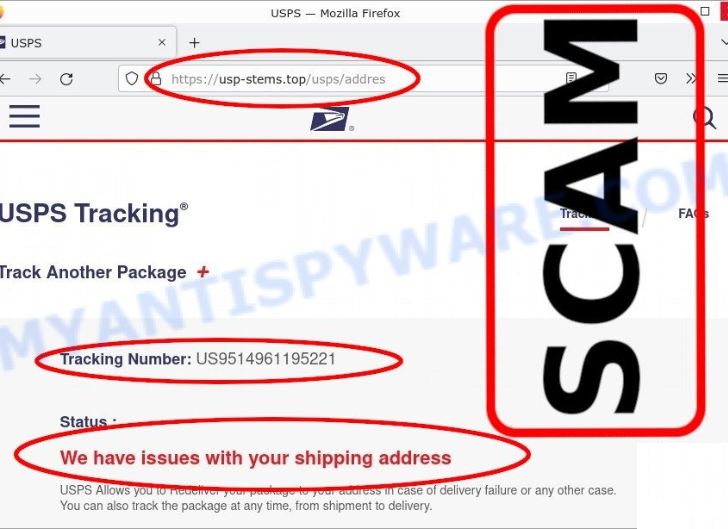Is The Delivery on Hold Text From USPS With Tracking ID “US9514961195221” Legit?
Is The Delivery on Hold Text From USPS With Tracking ID “US9514961195221” Legit? If recently receive a text from USPS concerning a failed delivery, Find Out What It Means In This Article.![]()
In today’s digital age, scams and fraudulent activities have become increasingly sophisticated. One common method scammers use to deceive individuals is through text messages and emails that appear to be from legitimate organizations. For many, a text from the United States Postal Service (USPS) claiming that a package is on hold can be a cause for concern.
In this article, we will investigate the legitimacy of a text message claiming to be from USPS with the tracking ID “us9514961195221” and offer guidance on how to determine whether such messages are genuine or fraudulent.
The Proliferation of Delivery Scams
With the rise in online shopping, parcel deliveries have become a regular part of our lives. This convenience, however, has also opened the door for scammers to exploit individuals. Delivery scams are increasingly common, and they often take the form of text messages or emails that claim a package is on hold due to an issue with shipping or requires additional payment to be released.
The USPS, being a prominent courier service in the United States, is a common target for such scams. Scammers often impersonate USPS in their communications, leading people to believe that the messages are legitimate. This is where skepticism and caution come into play.
Analyzing the Text Message: How Does The Text Works?

To determine the legitimacy of a text message claiming to be from USPS with the tracking ID “us9514961195221,” several factors should be considered:
- Sender Information: Legitimate USPS messages typically come from a recognizable sender, such as “USPS” or “United States Postal Service.” Verify that the sender’s name and contact information match the official USPS contact details.
- Grammar and Spelling: Scammers often make mistakes in grammar and spelling. Carefully review the text message for any errors or inconsistencies in language use.
- Links and Attachments: Avoid clicking on any links or downloading attachments from suspicious messages. These may contain malware or direct you to fraudulent websites.
- Request for Personal Information: Be cautious if the message requests personal information, such as your Social Security number, credit card details, or other sensitive data. USPS will not typically request such information via text.
- Urgent Language: Scammers often use urgency to pressure recipients into taking immediate action. If the message is overly urgent or threatening, it may be a red flag.
- Tracking ID Verification: To verify the legitimacy of a tracking ID like “us9514961195221,” visit the official USPS website (https://www.usps.com) and use their tracking tool to enter the provided ID. If it doesn’t match any real shipments, it’s likely a scam.
- Contact USPS Directly: When in doubt, contact USPS directly using their official customer service contact information, which can be found on their website. They can confirm whether the message is legitimate and provide guidance on any real issues with your shipment.
Common Scam Tactics You Should Know
Scammers employ several tactics to deceive individuals in delivery-related scams. Some of the most common tactics include:
- Fake Fees: Scammers may claim that you need to pay additional fees to release your package. USPS typically does not require additional payments via text message.
- Malware and Phishing Links: Clicking on links or downloading attachments in scam messages can lead to malware infections or phishing attempts, compromising your personal information.
- Identity Theft: Scammers may attempt to collect personal information from you, such as Social Security numbers, to commit identity theft.
- Threats and Intimidation: Some scam messages use threatening language to coerce recipients into taking immediate action. Remember that legitimate organizations do not use threats in their communications.
Frequently Asked Questions Regarding USPS Tracking ID “us9514961195221”
Here are some frequently asked questions (FAQs) regarding USPS Tracking ID “us9514961195221”:
1. What is a USPS Tracking ID?
A USPS Tracking ID is a unique number assigned to each package or shipment sent via the United States Postal Service (USPS). It allows both senders and recipients to track the progress and location of the package in real-time.
2. Is “us9514961195221” a legitimate USPS Tracking ID?
The legitimacy of a USPS Tracking ID depends on whether it was issued by USPS for a genuine shipment. To verify the authenticity of “us9514961195221,” you should use USPS’s official tracking tool on their website or contact USPS directly.
USPS Tracking Site: https://tools.usps.com/go/TrackConfirmAction_input
3. I received a text message with this tracking ID. Is it safe to click on the link provided?
Be cautious when clicking on links in text messages, especially if you didn’t expect to receive the message. Scammers often use fake tracking IDs in phishing attempts. To verify the message’s legitimacy, avoid clicking the link and use USPS’s official website to track your package.
4. The text message with “us9514961195221” asks for personal information. Should I provide it?
USPS typically does not request personal information via text messages. If the message asks for personal data like Social Security numbers or payment details, it’s likely a scam. Do not provide any sensitive information and report the message to USPS.
5. What should I do if I suspect a USPS tracking message is a scam?
If you suspect a message is a scam, do not engage with it further. Instead, report it to USPS and delete the message. You can also contact USPS through their official customer service channels to confirm the status of your package.
6. How can I verify the status of my package with “us9514961195221”?
To verify the status of your package with tracking ID “us9514961195221,” visit the official USPS website (https://www.usps.com) and use their tracking tool. Enter the tracking ID to check the real-time status and location of your package.
7. I received a similar message from a different tracking ID. What should I do?
If you receive unsolicited text messages or emails with tracking IDs you didn’t expect, follow the same precautions. Do not click on any links or provide personal information. Verify the message’s legitimacy using official USPS channels.
8. How can I protect myself from USPS-related scams?
To protect yourself from USPS-related scams, be vigilant. Verify the sender’s information, check for spelling and grammar errors, avoid clicking on links in unsolicited messages, and never provide sensitive information unless you are certain the message is legitimate. Report suspicious messages to USPS.
9. Can I contact USPS directly to confirm the status of my package?
Yes, you can contact USPS directly to confirm the status of your package. Visit the official USPS website for their contact information or visit your local post office for assistance.
10. What other steps can I take to avoid falling victim to package-related scams?
Stay informed about common scams, regularly check your email and text message settings for security options, and consider using spam filters or email verification tools to identify potentially fraudulent messages. Always err on the side of caution when dealing with unsolicited messages.
Remember that scammers often target individuals with fake package-related messages, so it’s crucial to verify the legitimacy of such messages to protect your personal information and financial security.
Conclusion
The text message claiming to be from USPS with the tracking ID “us9514961195221” should be approached with caution. While it is not possible to definitively determine its legitimacy without additional context, there are key factors to consider when evaluating such messages. Always prioritize your online safety and privacy.
If you receive a message that raises suspicions, follow the steps outlined in this article. Contact USPS through official channels to verify the status of your shipment or to report any potential scams. In an era where digital deception is rampant, staying vigilant and informed is essential to protect yourself from fraud and scams.
Kindly Share This Post: If you think this post can be helpful to somebody else, please share it using the buttons below!!!


